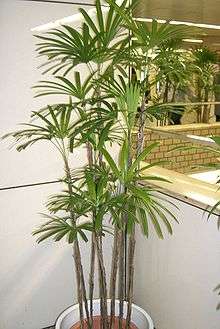Rhapis
Rhapis is a genus of about 10 species of small palms native to southeastern Asia from southern Japan and southern China south to Sumatra.[1] The species are commonly known as lady palms. They are fan palms (subfamily Coryphoideae), with the leaves with a bare petiole terminating in a rounded fan of numerous leaflets. The plants have thin stems growing to 3–4 m tall, branching at the base, forming clumps and are dioecious, with male and female flowers produced on separate plants.
- Rhapis cochinchinensis (Lour.) Mart. - Thailand; Laos; Vietnam
- Rhapis excelsa (Thunb.) A.Henry - China: Fujian, Guangdong, Guizhou, Hainan, Yunnan; Vietnam; naturalized in Thailand; Japan: Ryukyu Islands
- Rhapis gracilis Burret - China: Guangdong, Guangxi, Hainan; Vietnam
- Rhapis humilis Blume - China: Guangxi, Guizhou; Vietnam; naturalized in Japan and Java
- Rhapis micrantha Becc. - Laos; Vietnam
- Rhapis multifida Burret - China: Guangxi, Yunnan
- Rhapis puhuongensis M.S.Trudgen, T.P.Anh & A.J.Hend. - Vietnam
- Rhapis robusta Burret - China: Guangxi; Vietnam
- Rhapis subtilis Becc. - Thailand; Laos; Cambodia; Indonesia: Sumatra
- Rhapis vidalii Aver., T.H.Nguyên & P.K.Lôc - Vietnam
| Lady palms | |
|---|---|
 | |
| Rhapis humilis | |
| Scientific classification | |
| Kingdom: | Plantae |
| Clade: | Tracheophytes |
| Clade: | Angiosperms |
| Clade: | Monocots |
| Clade: | Commelinids |
| Order: | Arecales |
| Family: | Arecaceae |
| Subfamily: | Coryphoideae |
| Tribe: | Trachycarpeae |
| Genus: | Rhapis L.f. ex Aiton |
Cultivation and uses
Several species are cultivated as ornamental plants, of which Rhapis excelsa is the most common. Rhapis excelsa and some other species are relatively cold tolerant and can be grown outdoors in subtropical or warm temperate climates. Rhapis excelsa was listed by NASA as one of the best plants for removing toxins from the air.[2]